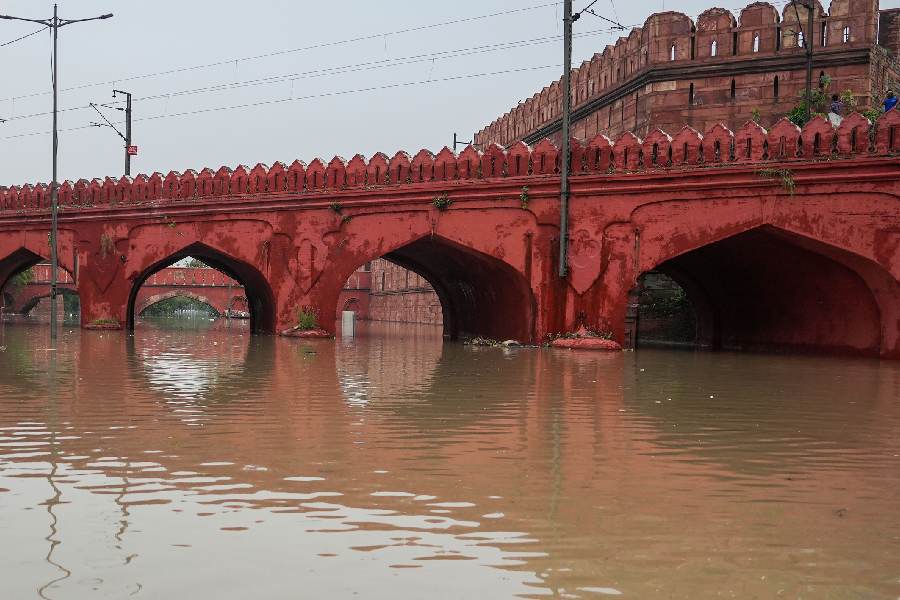A surge in discharge from the Hathnikund Barrage into the Yamuna following heavy rain in parts of Uttarakhand and Himachal Pradesh is expected to increase the water level of the river in Delhi and impact relief and rehabilitation work in the flood-affected low-lying areas of the capital, officials said on Saturday.
The river water level, which has been hovering around the danger mark of 205.33 metres for the last few days, dropped below the threshold again on Saturday morning.
The Central Water Commission's (CWC) data showed the water level dropped to 205.16 metres at 4 pm on Saturday. It may drop further before the impact of rain in upper catchment areas becomes clear.
The India Meteorological Department has predicted heavy to very heavy rain in parts of Himachal Pradesh and Uttarakhand till July 25.
In Uttarakhand, Haripur (126.8 mm) and Haldwani (122 mm) reported very heavy rainfall, while Mussorrie (112mm), Chakrata (83 mm), Loharkhet (68 mm), Dunda (91 mm), Purola (90 mm), Mori (77 mm), Barkot (72 mm), Chinyalisaur (65 mm), Gairsain (85 mm), Berinag (95.6 mm), Didihat (79.8 mm) and Pithoragarh (76.3 mm) received heavy rainfall.
In Himachal Pradesh, Renuka/Dadhau (195 mm), Pachhad (103.3 mm) Nahan (91.4 mm), Chaupal (90 mm) Sundarnagar (87.7 mm), Mandi Solan (86 mm), Arki (70 mm) and Rohra (70 mm) recorded heavy to very heavy rainfall in 24 hours ending 8.30 am on Saturday.
According to the CWC data, the flow rate at the Yamunanagar-located Hathnikund Barrage crossed the 1 lakh-mark at 9 am and oscillated between 2 lakh and 2.5 lakh cusecs between 10 am and 4 pm.
"Discharge from Hathnikund Barrage remained above 2 lakh cusecs mark for seven hours after overnight rain in upper catchment areas of the Yamuna, with peak discharge being 2,51,987 cusecs recorded at 2 pm. This significant volume of water is expected to reach Delhi within 36 hours, posing a risk of mid-scale floods in the capital, which is still recuperating from one of the worst flood spells it experienced in the second week of July.
"The second spell of floods will likely see the Yamuna river reclaiming most of its floodplain in Delhi. Given the valuable insights gained from the last flood spell this month, city planners and policy makers must take note of the lessons learned. It is imperative for the relevant government departments to be on high alert and maintain internal coordination.
"Citizens are counting on the swift response of authorities, expecting all the gates of the ITO barrage to be opened and fully functional. Additionally, immediate attention should be given to fix any breached sites and bunds," said Bhim Singh Rawat, associate coordinator of the South Asia Network on Dams, Rivers and People.
There have been marginal fluctuations in the water level over the last four to five days amid rain in the upper catchment areas, primarily in Himachal Pradesh and Uttarakhand.
Delhi Irrigation and Flood Control Department officials said heavy rains upstream of Delhi will impact rehabilitation of the affected families in the inundated low-lying areas of the capital and they may have to stay in relief camps for a longer period.
It could also impact the water supply in the city, which became normal only on Tuesday after being affected for four or five days due to the inundation of a pump house at Wazirabad.
The pump house supplies raw water to Wazirabad, Chandrawal and Okhla treatment plants, which together account for around 25 per cent of the city's supply.
Parts of Delhi have been grappling with waterlogging and flooding for more than a week now. Initially, a downpour caused intense waterlogging on July 8 and 9, with the city receiving 125 per cent of its monthly rainfall quota in just two days.
Subsequently, heavy rains in the upper catchment areas of the Yamuna, including in Himachal Pradesh, Uttarakhand and Haryana, led to the river swelling to record levels.
At 208.66 metres on July 13, the Yamuna surpassed its previous record of 207.49 metres set in September 1978 by a significant margin. It breached embankments and penetrated deeper into the city than it has in over four decades.
The consequences of the floods have been devastating, with more than 27,000 people evacuated from their homes. The losses incurred in terms of property, businesses and earnings have run up to crores.
Experts attribute the unprecedented flooding in Delhi to encroachment on the river floodplain, extreme rainfall within a short span of time and silt accumulation that has raised the riverbed.
Except for the headline, this story has not been edited by The Telegraph Online staff and has been published from a syndicated feed.











